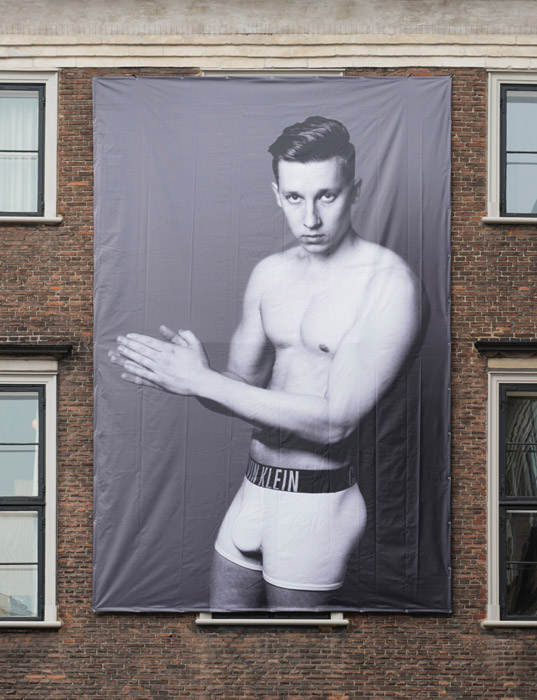Exhibition
in Birsfelden / Switzerland
- © Artor Jesus Inkerö, Photo by David Stjernholm
- © Josefin Andersson, Klara Ström & Hannah Wiker Wikström, Photo by David Stjernholm
- © Helene Nymann, Photo by David Stjernholm
- © Vidha Saumya, Photo by David Stjernholm
Nanna Abell, Sigudur Amundason, Josefin Andersson, Klara Ström & Hannah Wiker Wikström, Zoe Barcza, Mira Eklund, Artor Jesus Inkerö, Yassine Khaled, Eirik Saether, Helene Nymann, Vidha Saumya
“I Am Our Common Pronoun” takes its title from “I Civil” (2012), a book by the Danish writer and artist Amalie Smith, which considers the body as a porous container of shards that connect and separate us from the world and each other. This exhibition shares Smith’s exploration of the self in contemporary life: how it is constituted through language – and by extension all modes of representation – and how, therefore, it can also be expanded or broken down in an effort to express identification, empathy, love, and belonging.
Through the work of eleven emerging artists and collectives living in five Nordic countries, this exhibition traces experiences, experiments, and propositions for imagining the self in contemporary society as something constructed and broken apart by networked culture, migration, increased isolation, and gender fluidity. The exhibition presents works that depart from a rigorous self-examination, in which the body is considered a form akin to others; it may function as a medium, thought of in terms of sculpture and/or performance, as a way to consider what it means to identify with the needs, desires, and suffering of others.
Clothing, costumes, and drag, are an external layer that perform gender. By extension, how we live our lives is shaped by architecture and its interiors; Decor, for instance, is akin to how we dress: layers of containers for identity that can be manipulated to affect how we relate to other people and how we constitute our sense of self. Walls, like clothing, affect how we move in the world. In Eirik Sæther‘s site-specific installation “China” (2017), the artist flips generic, kitsch, transnational hotel architecture upside down, pointing to this usually invisible structure that collects transient strangers as they move between places and events. The relationship between these external layers and the subject(s) inside them come together and impact how we exist in the world, as in “The Nasty Surprise” (2017), a performance in three parts by Josephine Jussi Andersson, Klara Ström, and Hannah Wiker Wikström who use their voices and movements to tie together bodies and objects in a performative environment.
The ballpoint pen drawings of Vidha Saumya are a means of expanding and reacting to her own desires through identification with the seemingly absurd desires of others. In Artor Jesus Inkerö‘s “Justin” (2016), “Kim”, and “Caitlyn”, the artist undertakes an extreme lifestyle shift in order to produce images of three infamous public figures from the artist’s own body.
A stark counterpoint to the common, self-centered project of developing one’s own identity or ‘self-branding’ for display on social media and performed in public life, these artists use identity as a way to look out into the world through a critical lens in search of empathy. On the one hand, Yassine Khaled‘s “Monitor Man” (2016) uses his body and technology to create one-to-one conversations between people he encounters on the streets of Europe and people living in non-Western countries, whereas Sigurður Ámundason uses basic materials in his drawings to explore how the stable self might be a complex composition of multiple or split identities.
The works may stem from a will to identify with other humans, creatures, or objects and to open up the self – and by extension, these ideas – in a porous way to produce a consciousness that is anything but individual. In her paintings, Zoe Barcza depicts her body, literally opening it up to her environment. Mira Eklund invokes the voice of her late father as a way to connect to someone through the traces they left behind, and Helene Nymann‘s video of a ballet dancer interpreting Japanese Butoh dance presents a mode of understanding the self in relation to the tradition and trauma of another time and place.
“I Am Our Common Pronoun” is, therefore, a declaration of collective identification which is as much a proposition for inclusion as it is a threat to the self’s (imagined) sovereignty.
This exhibition is curated by Helga Christoffersen; it is the first public component of a three-year long research project on emerging artists in the Nordic countries, initiated by Christoffersen as a response to CHART’s invitation to organise CHART EMERGING 2017 in Copenhagen in late August. ‘Emerging’, in this project, refers to artists, who, having completed the formal educational phase of their development, have recently put forth a distinct position within the larger artistic landscape. ‘Emerging’ therefore does not refer to an age as much as a budding moment of artistic development.
“I Am Our Common Pronoun” was produced through extensive research and travel in Denmark, Finland, Iceland, Norway, and Sweden; it is meant to amplify thematic resonances which emerged between the work of this group of artists. The exhibition, therefore, is not a regional survey, rather, it points to a specific set of concerns. A larger survey of emerging artists in the Nordic countries, which also extends from this research, will follow in book format and as an online resource, forming the next phases of this project.
SALTS is kindly supported by Swisslos Basel-Landschaft, Fondation Nestlé pour l’Art, the Swiss Arts Council Pro Helvetia, Stiftung Roldenfund and Migros Kulturprozent.
Gallery hours by appointment only, please call +41 79 372 81 75
Location:
SALTS
Hauptstrasse 12
4127 Birsfelden
Switzerland





